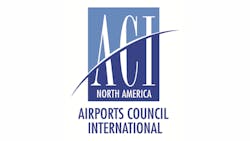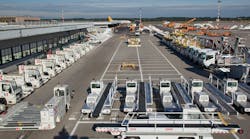Airport directors representing Airports Council International – North America (ACI-NA), the industry trade association for commercial service airports in the United States and Canada, on Feb. 9, participated in a meeting with President Donald J. Trump, senior White House officials, and Airlines for America at the White House. During the meeting, airports and airlines discussed opportunities to improve the passenger experience, modernize airport infrastructure, and create jobs in local communities across the United States.
ACI-NA President and CEO Kevin M. Burke joined ACI-NA members participating in the meeting, including William R. Vanecek, director of aviation, Buffalo Niagara International Airport and chair of ACI-NA; Ginger S. Evans, commissioner, Chicago Department of Aviation; Deborah Flint, CEO, Los Angeles World Airports; Patrick J. Foye, executive director, Port Authority of New York and New Jersey; Joseph W. Lopano, CEO, Tampa International Airport; John E. Potter, president and CEO, Metropolitan Washington Airports Authority; Robert R. Wigington, president and CEO, Metropolitan Nashville Airport Authority.
“We greatly appreciate the President’s persistent, vocal support for building airport infrastructure as a key component of improving the passenger experience, rebuilding our nation, growing our economy, and creating jobs,” said Burke. “We had a very productive conversation today that focused on our commitment to improving the passenger experience at airports across the United States.”
“During the meeting, the President stated four times that America must modernize and rebuild our airports,” said Burke. “We can quickly fund and undertake these much needed infrastructure projects with no federal budget impact by giving airports more control of local investment decisions. We estimate that 2.1 million jobs could be created while enhancing the passenger experience simply by removing federal limits on the local user fee known as the Passenger Facility Charge.”
Policy priorities raised by airports included:
- Airport Infrastructure: ACI-NA urged the president to modernize our aging infrastructure by getting Washington out of the way of local investment decisions. These decisions should be locally controlled. The simplest policy solution – removing federal limits on the local user fee known as the Passenger Facility Charge and restoring decision-making to local airports – would allow needed projects to move forward quickly with no federal budget impact.
- Aviation Security: The United States can enhance aviation security and improve the international arrivals process by ensuring TSA and CBP have the officers and technology necessary to provide effective and efficient screening of passengers. ACI-NA also urged the President to expand TSA PreCheck and other Trusted Traveler programs to reduce security screening wait times, which are a source of great frustration to travelers.
- Air Service: ACI-NA asked the president to help improve air service options by giving airports more flexibility in spurring competition and attracting more airlines to their communities.
- Air Traffic Control Reform: We shared our concerns with the president about potential reforms to air traffic control management. If the benefits are to be realized, investment is required in all phases of flight, including airport runways and taxiways, ground based equipment, satellite data systems, cockpits and control towers. The governance structure must include all stakeholders if it is to be successful.
Key Airport Facts:
- Nearly 1.2 million people work at America’s airports. Airports support nearly 10 million jobs in local communities across the country. Airports contribute more than $1.1 trillion in economic output annually.e
- The average airport facility in the United States is more than 40 years old. The youngest large hub airport is 21 years old.
- America’s airports have more than $100 billion in infrastructure needs over the next five years. That’s more than $20 billion a year.


